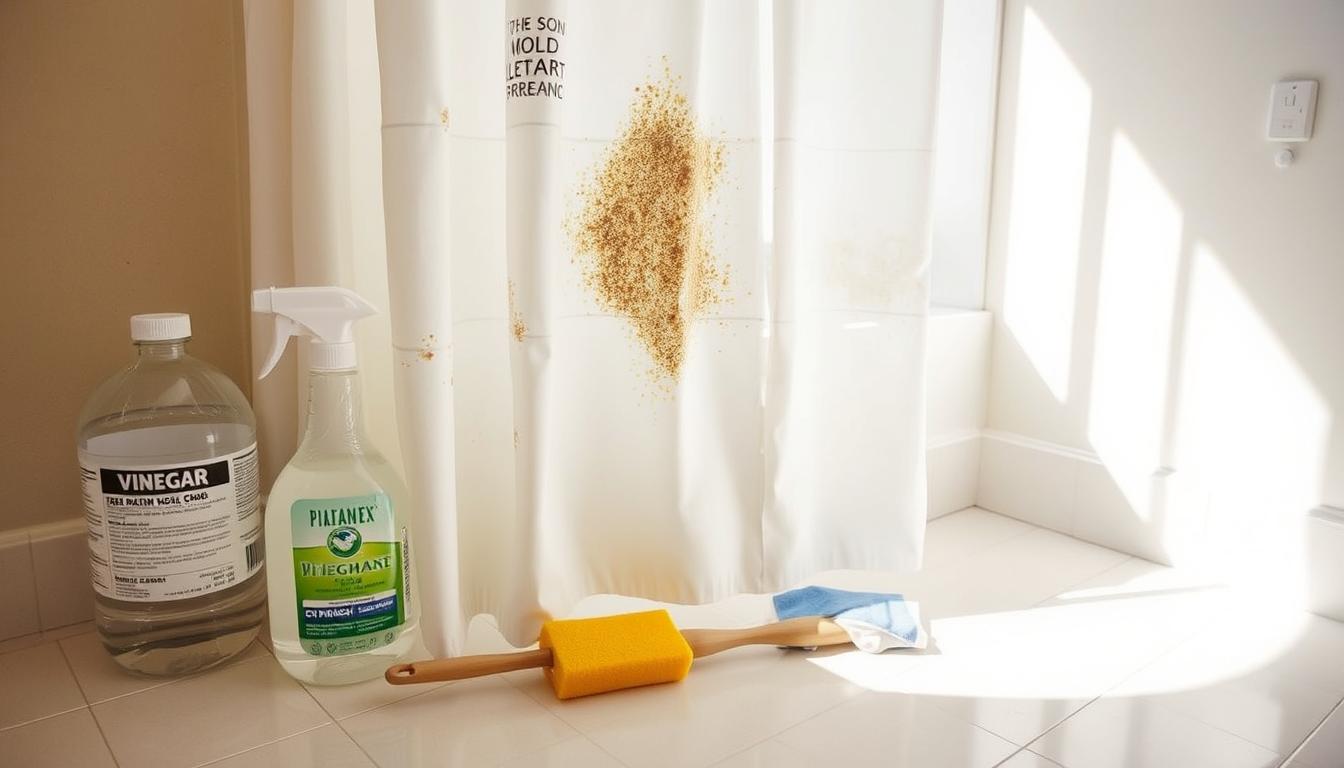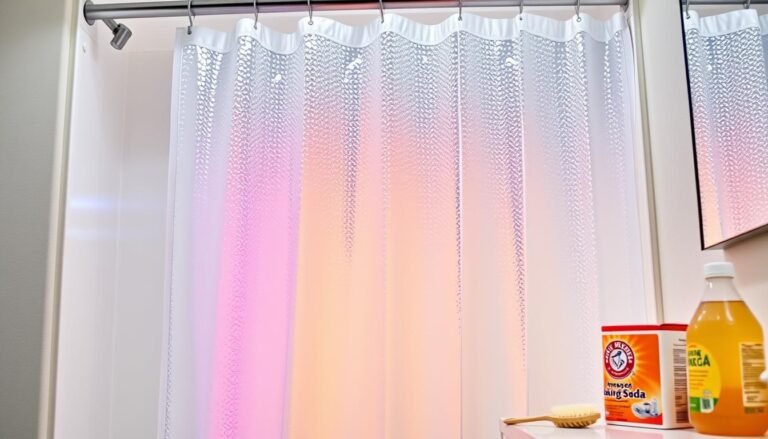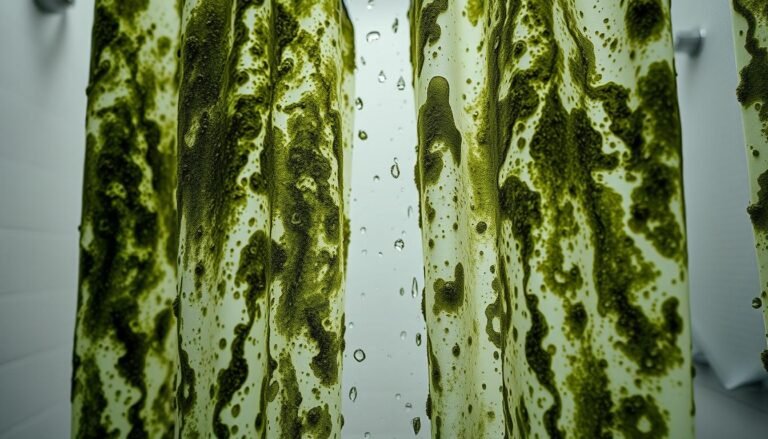Eradicate Mold from Shower Curtain Easily
Fighting mold on your shower curtain is not as hard as it seems. You can get rid of it and stop it from coming back. It’s important to handle mold on shower curtains to keep your bathroom clean and healthy. If your shower curtain liner has mold on more than 10% of it, throw it away. Put it in a sealed plastic bag and dispose of it outside to avoid spreading mold.
Mold grows because bathrooms are often wet and not well-ventilated. It doesn’t matter if your curtain is fabric or vinyl; mold loves damp spots. Cleaning your curtain often can help prevent mold. If mold gets really bad, try home remedies like vinegar or baking soda with hydrogen peroxide. The CDC says to wash your shower curtain every season, or more often in warm, humid places.
For help, go to Cover Advice for detailed steps to treat and stop mold on shower curtains and other items. Following the right disposal and cleaning steps will help keep your bathroom clean and free from mold.
Understanding Mold on Shower Curtains
Mold and mildew like warm, moist places, and bathrooms are perfect for them. They grow on shower curtains because of the moisture and bits of organic stuff, like skin cells. Knowing why mold forms is a step towards stopping it. This includes using techniques for shower curtain mold prevention.
Causes of Mold and Mildew
Mold loves moisture, warmth, and organic material. This makes shower curtains a hotspot for growth. Bathrooms get humid from hot showers, boosting mold’s chances.
Without good air flow, moisture sticks around and mold grows. Mold feasts on stuff like soap scum and body oils found on shower curtains.
Health Risks Linked to Mold Exposure
Mold can make allergies and breathing problems worse. It causes eye irritation, skin issues, and asthma. There are different molds in bathrooms, like Cladosporium and Aspergillus. Each can harm health.
Quickly dealing with shower curtain mildew stops health problems from getting worse. It also prevents mold from spreading. Using good cleaning methods keeps your bathroom safe and healthy.
How to Remove Mold from Shower Curtain
Before you start to remove mold from your shower curtain, knowing how to clean different types of materials is key. This knowledge makes cleaning easier and faster.
Identifying the Type of Shower Curtain Material
The kind of material your shower curtain is made from will decide how you should clean it. Fabric curtains can go right into the washing machine. Add a bit of laundry soap, vinegar, and baking soda for the best results. Plastic curtains, however, need gentler care. A mix of bleach and water, half and half, works great for cleaning these.
Putting bath towels in the wash helps get rid of dirt and keeps curtains from getting wrinkly. But, don’t use fabric softener; it can make things dirtier. Always air dry vinyl and plastic curtains to keep their shape. And, be sure to check the care label for any special instructions on washing cycles and detergents.
Immediate Steps Before Cleaning
There are a few things to do before you start cleaning. Take the curtain off its rings first. Look over it for any clear signs of mildew. A bleach and water solution is great for treating spots directly. Or, try a mix of baking soda and dish soap on a sponge for another way to tackle mold.
Here are more tips for keeping mold away from your shower curtain:
- Use a vinegar spray regularly to stop mold from forming.
- Hang the curtain open after showers to let it dry and lower moisture.
- Try a store-bought shower spray for extra mold prevention.
Preventing mold is key. Clean your liners monthly as a general rule. But, if your bathroom is used a lot, clean them every two or three weeks instead.
| Cleaning Method | Material | Duration |
|---|---|---|
| Hand Cleaning with Bleach Solution | Vinyl/Plastic | 20-35 minutes + 15-25 minutes downtime |
| Washing Machine with Laundry Detergent | Fabric | Wash cycle + 10 minutes downtime |
| Scrubbing with Baking Soda and Dish Soap | Plastic Liners | 20-35 minutes |
Using Vinegar for Mold Removal
Distilled white vinegar is a powerful tool for DIY mold removal on shower curtains. It’s known for its ability to kill mold. This makes it a great, eco-friendly choice for those wanting an affordable solution. By following simple steps, your shower curtain can be mold-free and smell fresh.
Soaking the Shower Curtain in Vinegar
Start by taking down the curtain and placing it in a tub or large bucket. Fill it with undiluted distilled white vinegar so the curtain is completely covered. Let it soak for an hour to break down the mold and soap scum effectively.
Washing and Air-Drying the Curtain
After soaking, move the curtain to the washing machine if it’s machine-washable. Use warm water and mild detergent to wash away residue. For delicate fabrics, hand-wash with a soft brush or sponge to avoid damage. Once clean, hang the curtain in a breezy spot to dry. This prevents moisture buildup, stopping future mold growth.
Regularly cleaning your shower curtain keeps your bathroom healthy. DIY mold removal saves money and keeps your space mold-free. Washing and drying regularly greatly lowers mold’s chances of coming back.
For extra bathroom cleaning tips, check out this detailed guide on when to drain pool cover. It offers helpful advice for keeping your bathroom clean and mold-free.
| Method | Process | Frequency |
|---|---|---|
| Soaking in Vinegar | Soak curtain in undiluted vinegar for one hour | Every 2-3 months |
| Machine Wash | Wash with mild detergent in warm water | As needed |
| Hand Wash | Scrub with a soft brush or sponge | As required |
| Air Dry | Hang in a well-ventilated area | After each cleaning |
Baking Soda and Hydrogen Peroxide Method
When you’re dealing with stubborn mold on your shower curtain, use baking soda and hydrogen peroxide. This combo works well on both plastic and fabric curtains. It kills mold and bleaches stains effectively.
Creating a Baking Soda Paste
Begin by making a baking soda paste. Just mix one part water with enough baking soda until it’s thick. This paste is great for tackling mold on curtains.
Applying and Scrubbing for Effective Cleaning
Spread the paste on the moldy parts of your curtain. Let it sit for about 10-15 minutes. During this time, mix two parts hydrogen peroxide with one part water. Then, gently scrub the areas with a soft brush.
After scrubbing, spray the peroxide mix on those areas. This solution acts as bleach and kills mold well. Let it stay on for 15 more minutes before rinsing it off with water.
After cleaning, let your curtain air-dry to keep moisture away. This method, along with monthly cleanings, will keep your curtains mold-free. For more tips, check out this guide on cleaning shower curtains.
| Solution | Benefits | Frequency |
|---|---|---|
| Baking Soda Paste | Effective in scrubbing away mold and mildew. | Apply during each deep clean. |
| Hydrogen Peroxide Solution | Disinfects and bleaches mold stains. | Use after baking soda treatment. |
| Vinegar Solution | Prevents future soap scum build-up. | Incorporate into monthly cleanings. |
Cleaning Mold with Borax
Borax is a powerful, natural fungicide. It’s great for removing mold from shower curtains. Unlike many cleaners, it doesn’t release harmful fumes. The best method for cleaning involves simple steps.
Start by mixing 1/2 cup of borax with a gallon of water. This creates a strong solution thanks to borax’s alkaline properties. Soak your moldy curtain in this mix for at least 30 minutes.
After soaking, wash the curtain in your machine. Add a cup of baking soda for extra cleaning. For plastic curtains, use a cool setting to prevent damage. Periodically, spray a vinegar and water mix on the curtain to stop mold growth.
When using borax, wearing gloves is smart to protect your skin. A clean curtain makes your bathroom look better and healthier. For more cleaning tips, check out Advanced Clean’s Complete Guide.
The table below shows steps and tips for effective borax use:
| Step | Action | Tip |
|---|---|---|
| 1 | Mix 1/2 cup of borax with a gallon of water | Borax’s alkaline properties target mold effectively |
| 2 | Soak the shower curtain for at least 30 minutes | Ensure complete submersion for maximum effectiveness |
| 3 | Wash in a regular cycle with baking soda | Plastic curtains should be washed on a cool setting |
| 4 | Air-dry the shower curtain | Air drying prevents warping and mold return |
| 5 | Spray with a vinegar and water solution | Prevents future mold and mildew growth |
Following these steps will keep your curtain mold-free. Knowing how to clean your shower curtain right is essential for a healthy bathroom.
Preventive Measures to Keep Mold at Bay
It’s not just about cleaning now and then. Taking steps to prevent mold is key. You can cut down the risk of mold in your bathroom with a few smart moves. Use proper ventilation, keep up with cleaning, and choose mold-resistant items to keep your space healthy.
Improving Bathroom Ventilation
To stop mold, make sure your bathroom is well-ventilated. Mold loves damp places, and keeping humidity between 35% and 50% helps. Use a fan or open a window during and after showers to kick out extra moisture. If needed, a dehumidifier can help keep things dry.
Regular Cleaning and Maintenance Tips
Regular upkeep stops mold from growing. Clean your shower items monthly to keep mold away. Spraying the liner weekly and using a squeegee after showers also helps. Plus, a deep clean every week fights mold growth.
Try using vinegar, baking soda, and tea tree oil for cleaning. They’re safe and fight mold well. Always stretch out the curtain to dry after showers. Mold-resistant products and special cleaners also keep your shower looking new.
Mold can harm your health, especially if you have breathing problems. Following these steps helps keep your bathroom mold-free. This means a safer, cleaner space for everyone.

Hey there, I’m Alex Hanson and I’m passionate about all things covers! Whether you’re looking for a car seat cover to protect your vehicle or an oven cover to keep your kitchen clean, I’m here to help. With years of experience in the industry, I have plenty of knowledge and insights to share with my readers. So, if you care about protecting your belongings and making them look their best, you’re encouraged to read my blog as I explore the perfect cover for every need.







